(完整)人教版七年级下册英语总复习资料
人教版初中英语七年级下册知识点总结
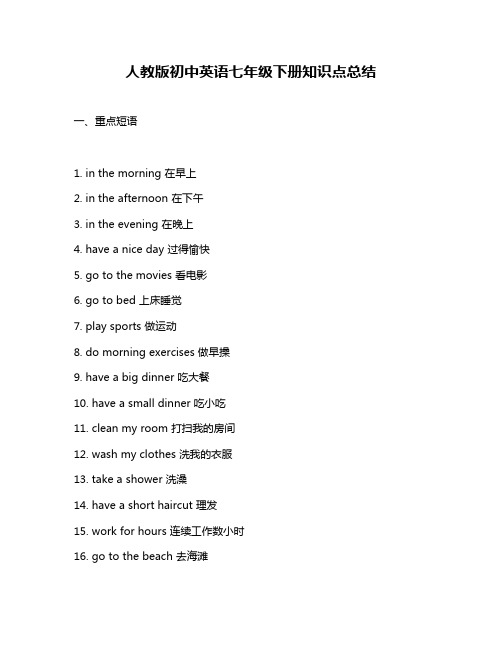
人教版初中英语七年级下册知识点总结一、重点短语1. in the morning 在早上2. in the afternoon 在下午3. in the evening 在晚上4. have a nice day 过得愉快5. go to the movies 看电影6. go to bed 上床睡觉7. play sports 做运动8. do morning exercises 做早操9. have a big dinner 吃大餐10. have a small dinner 吃小吃11. clean my room 打扫我的房间12. wash my clothes 洗我的衣服13. take a shower 洗澡14. have a short haircut 理发15. work for hours 连续工作数小时16. go to the beach 去海滩17. on the weekend 在周末18. listen to music 听音乐19. have a party 举办聚会20. watch TV 看电视21. play computer games 玩电脑游戏22. in the pool 在游泳池里23. go to the zoo 去动物园24. in the mountains 在山里25. have fun 玩得开心26. the great wall 长城27. many places of interest 名胜古迹28. be ready for 为……准备好29. stay healthy 保持健康30. how much 多少31. would you like 一些……吗?32. some noodles 一些面条33. order a pizza 定一个披萨饼34. make a phone order 电话订购35. would you like to do sth 你愿意做某事吗?36. want to do sth 想做某事37. would you like +名词你愿意要……吗?38. would you like +动词不定式你愿意……吗?39. choose some food 选择一些食物40. order the food 订购食物41. be careful 当心;小心42. not much 不多;少量的43. be ready to do sth 准备好做某事。
人教版七年级英语下册各知识点归纳总结
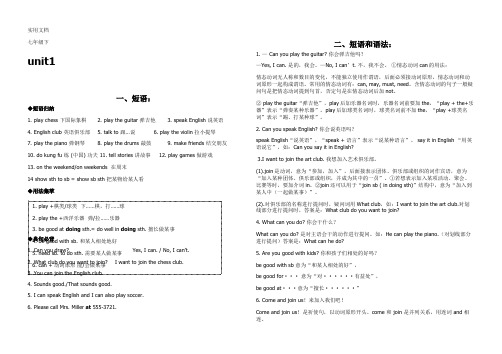
七年级下unit1一、短语:◆短语归纳1. play chess 下国际象棋2. play the guitar 弹吉他3. speak English 说英语4. English club 英语俱乐部5. talk to 跟…说6. play the violin 拉小提琴7. play the piano 弹钢琴8. play the drums 敲鼓9. make friends 结交朋友10. do kung fu 练 (中国) 功夫 11. tell stories 讲故事 12. play games 做游戏13. on the weekend/on weekends 在周末14 show sth to sb = show sb sth 把某物给某人看◆用法集萃◆典句必背1. Can you draw? Yes, I can. / No, I can’t.2. What club do you want to join? I want to join the chess club.3. You can join the English club.4. Sounds good./That sounds good.5. I can speak English and I can also play soccer.6. Please call Mrs. Miller at 555-3721.二、短语和语法:1. — Can you play the guitar? 你会弹吉他吗?—Yes, I can. 是的,我会。
—No, I can’t. 不,我不会。
①情态动词can的用法:情态动词无人称和数目的变化,不能独立使用作谓语,后面必须接动词原形,情态动词和动词原形一起构成谓语。
常用的情态动词有:can, may, must, need。
含情态动词的句子一般疑问句是把情态动词提到句首,否定句是在情态动词后加not。
人教版七年级下册英语期末复习:Unit 7-Unit 12 各单元语法知识点复习提纲(全面!)
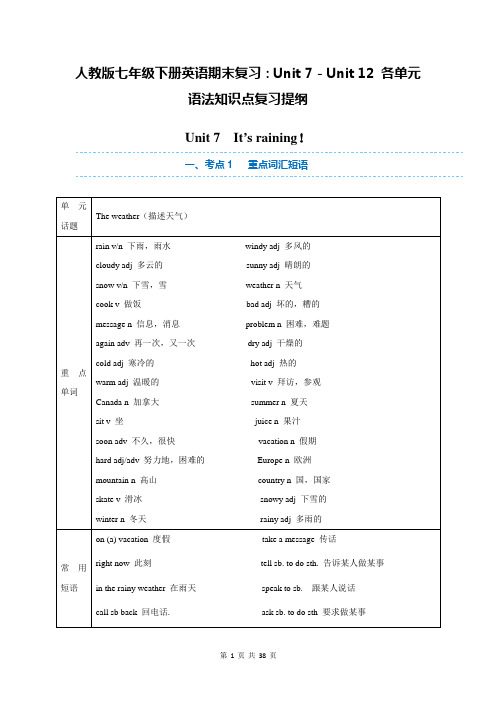
人教版七年级下册英语期末复习:Unit 7-Unit 12 各单元语法知识点复习提纲Unit 7 It’s raining!一、考点1 重点词汇短语1 messagemessage为可数名词,意为“消息,信息”,take a message for sb.“为某人捎个口信”。
拓展:give sb. a message 捎信给某人,leave a message 留口信,get the message 明白对方的意思。
Can I take a message for him?当某人发现要找的人不在或接电话的人发现打电话者要找的人不在时,常用此语2 could 情态动词意为“能,可以“,表示请求许可,在语气上比can委婉客气,但这种句式的肯定回答用can。
Could you just tell him to call me back?3 call及物动词,意为“打电话给”。
call sb. (up) “打电话给某人”,call sb. at +电话号码,意为“拨打……找某人”。
拓展:call 是一个多义词,call sb 可表示“叫醒某人,呼唤某人”;give sb. a call 给某人打电话。
4 back副词“回来,回原处,向后”;call sb. back给某人回个电话。
【即学即练】I’ll _____you _____.我将给你回电话。
5 visit此处用作及物动词,意为“拜访,探望”,后接表示人的名词或代词。
visit还可意为“参观,游览”,后接表示地点的名词。
拓展:visit还可用作可数名词,意为“访问,参观,拜访。
be on a visit to ... “正在访问/参观……”。
visitor参观者,游览者,游客。
I’m having a great time visiting my aunt in Canada._____ my grandparents every year at Christmas.我每年圣诞节都去探望我的祖父母。
人教版七年级下册英语知识点综合复习(完整版)

人教版七年级下册英语知识点综合复习(完整版) Unit 1 Can you play the guitar?1,情态动词+V原can do= be able to do2,Play+ the+ 乐器+球类,棋类3,join 参加社团、组织、团体4,4个说的区别:say+内容Speak+语言Talk 谈论talk about sth talk with sb talk to sbTell 告诉,讲述tell sb (not)to do sthTell stories/ jokes5,want= would like +(sb)to do sth6,4个也的区别:too 肯定句末(前面加逗号)Either否定句末(前面加逗号)Also 行前be 后As well 口语中(前面不加逗号)7,be good at+ V-ing=do well in 擅长于be good for 对…有益(be bad for对…有害)be good to 对…友好(good 可用friendly,nice,kind替换)be good with和…相处好=get on/ along well with8,特殊疑问句的构成:疑问词+一般疑问句9,How/ what about+V-ing …怎么样?(表建议)10,感官动词(look, sound, taste, smell, feel)+adj/ like11,选择疑问句:回答不能直接用Yes或者No,要从中选择一个回答12,students wanted for school show(wanted表示招募,含有被动意义)13,show sth to sb=show sb sth give sth to sb=give sb sth14,help sb (to)do sthHelp sb with sthWith sb’s help= with the help of sbHelp oneself to 随便享用15,be busy doing sth/ be busy with sth16,need to do sth17,be free= have time18,have friends= make friends19,call sb at +电话号码20,on the weekend= on weekends21,English-speaking students 说英语的学生(带有连词符,有形容词性质)22,do kung fu表演功夫Unit 2 What time do you go to school?1,问时间用what time或者whenAt+钟点at 7 o’clock at noon/ at night(during/ in the day)On+ 具体某天、星期、特指的一天on April 1st on Sunday on a cold winter morningIn +年、月、上午、下午、晚上2,时间读法:顺读法逆读法:分钟≤30用past five past eight(8:05)half past eight(8:30)分钟>30用to a quarter to ten(9:45)整点用…o’clock 7 o’clock(7:00)3,3个穿的区别:wear 表状态,接服装、手套、眼镜、香水等Put on 表动作,接服装Dress 表动作,接sb/ oneself get dressed穿衣3,感叹句:How+adj+主谓!How+adj+a/an +n单+主谓!What+ a/an +adj+ n单+主谓!What+ adj+ n复/ 不可数+主谓!4,from…to…5,be/ arrive late for6,频度副词(行前be 后)Always usually often sometimes seldom hardly never7,一段时间前面要用介词for for half an hour for five minutes8,eat/ have…for breakfast/ lunch/ dinner/ supper9,either…or10,a lot of=lots of11,it is +adj+for sb +to do sth (adj修饰to do sth)It is important for me to learn English.it is +adj+of sb +to do sth (adj修饰sb)It is kind/ friendly/ nice of you to help me.Unit 3 How do you get to school?1,疑问词How 如何(方式)how long 多长(时间)答语常用“(For/ about +)时间段”how far多远(距离)答语常用“(It’s +)数词 +miles/ meters/ kilometers”how often多久一次(频率)答语常用“Always/ often/ every day/…”或“次数+时间”等表频率的状语How soon多快,多久以后,常用在将来时中。
初中英语总复习资料七年级(人教版)

初中英语总复习资料七年级(人教版)初中英语总复习资料——七年级(人教版)初中英语总复习资料——七年级(人教版)一.知识网络【重点内容概要】1.元音字母在重读开音节、闭音节中的读音。
2.常用的日常交际用语。
3.人称代词,物主代词、指示代词及基数词。
4.动词be(am,is,,are)的用法及人称代词,名词的数的一致性,5.一些表示方位、地点介词的用法.6.名词所有格。
My father’s watch the pic of Billy billy’s pictures 7,冠词a,an,the的基本用法。
8.以What、Where、Who、Whose、Which、How等引导的疑问句和一般疑问句以及它们的回答.9.能灵活运用人称代词的主格和宾格.10.掌握可数名词和不可数名词的用法,以及与其搭配使用的相关修饰词11.There be句型以及与have(has)的运用及区别。
12.动词的现在进行时和一般现在时的运用。
13.祈使句的肯定、否定形式.14.常用的句型及交际用语。
15.人称代词主格和宾格的使用。
16.可数名词和不可数名词的运用.17.常用的句型。
18.现在进行时和一般现在时的使用。
【句型、词组精讲】Words and E_pressions1. E_cuse, me. / I’m sorry.这两个句子是会话时常用客套语。
1)E_cuse me. 表示“劳驾”,“请问”,“请原谅”,“对不起”,“打扰一下”等意思,多用于句首,主要用于在请求别人帮忙时用。
如:E_cuse me, is this watch yours?E_cuse me. How can I get to the station?2)I’m sorry. 或Sorry. 一般用于听到别人的不幸或做了对不起别人的事情表示遗憾或向其道歉,或不能够给对方提供信息或帮助时的场合。
如: I’m sorry I’m late. I’m sorry to hear your mother is ill.Sorry, I can’t go with you.Sorry, I won’t do that again.2. it’s / its1)it’s是it is的缩写形式,意思是“那是”。
人教版七年级下册英语各单元知识点总结归纳
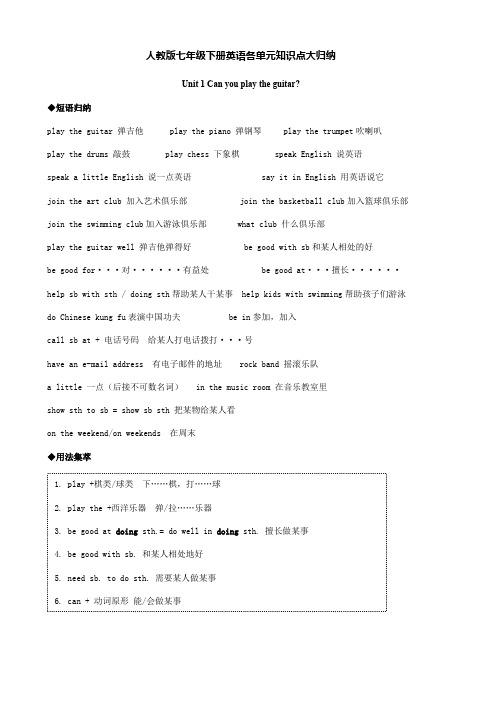
人教版七年级下册英语各单元知识点大归纳Unit 1 Can you play the guitar?◆短语归纳play the guitar 弹吉他 play the piano 弹钢琴 play the trumpet吹喇叭play the drums 敲鼓 play chess 下象棋 speak English 说英语speak a little English 说一点英语 say it in English 用英语说它join the art club 加入艺术俱乐部 join the basketball club加入篮球俱乐部join the swimming club加入游泳俱乐部 what club 什么俱乐部play the guitar well 弹吉他弹得好 be good with sb和某人相处的好be good for···对······有益处be good at···擅长······help sb with sth / doing sth帮助某人干某事 help kids with swimming帮助孩子们游泳do Chinese kung fu表演中国功夫 be in参加,加入call sb at + 电话号码给某人打电话拨打···号have an e-mail address 有电子邮件的地址 rock band 摇滚乐队a little 一点(后接不可数名词) in the music room 在音乐教室里show sth to sb = show sb sth 把某物给某人看on the weekend/on weekends 在周末◆用法集萃1. play +棋类/球类下……棋,打……球2. play the +西洋乐器弹/拉……乐器3. be good at doing sth.= do well in doing sth. 擅长做某事4. be good with sb. 和某人相处地好5. need sb. to do sth. 需要某人做某事6. can + 动词原形能/会做某事◆语法can 能;会;可以【用法】它本身有一定的含义,没有人称和数的变化,但不能单独作谓语,要和动词原形一起构成谓语。
人教版七年级下册英语总复习
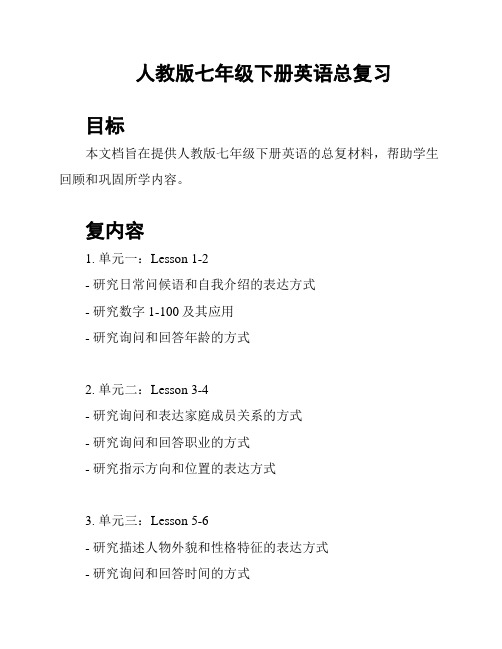
人教版七年级下册英语总复习
目标
本文档旨在提供人教版七年级下册英语的总复材料,帮助学生回顾和巩固所学内容。
复内容
1. 单元一:Lesson 1-2
- 研究日常问候语和自我介绍的表达方式
- 研究数字1-100及其应用
- 研究询问和回答年龄的方式
2. 单元二:Lesson 3-4
- 研究询问和表达家庭成员关系的方式
- 研究询问和回答职业的方式
- 研究指示方向和位置的表达方式
3. 单元三:Lesson 5-6
- 研究描述人物外貌和性格特征的表达方式
- 研究询问和回答时间的方式
- 研究表示频率的副词及其应用
4. 单元四:Lesson 7-8
- 研究描述人物喜好和日常活动的表达方式- 研究询问和回答能力和兴趣的方式
- 研究表达原因和结果的连词及其应用
5. 单元五:Lesson 9-10
- 研究描述家庭、房间和城市的表达方式- 研究询问和表达地点的方式
- 研究表示数量和价格的词汇及其应用
6. 单元六:Lesson 11-12
- 研究询问和回答日程安排的方式
- 研究表达喜怒和感受的形容词及其应用- 研究询问和表达能力和意愿的方式
复建议
- 复每个单元的重点词汇和常用句型
- 做相关单元的练题和听力练
- 跟读课文,注意语音和语调的准确性
- 制作复笔记,总结重点内容和常见问题- 参加口语练和模拟对话
祝愿同学们复习顺利,考试取得好成绩!。
人教版七年级英语下册总复习知识点考点总结归纳
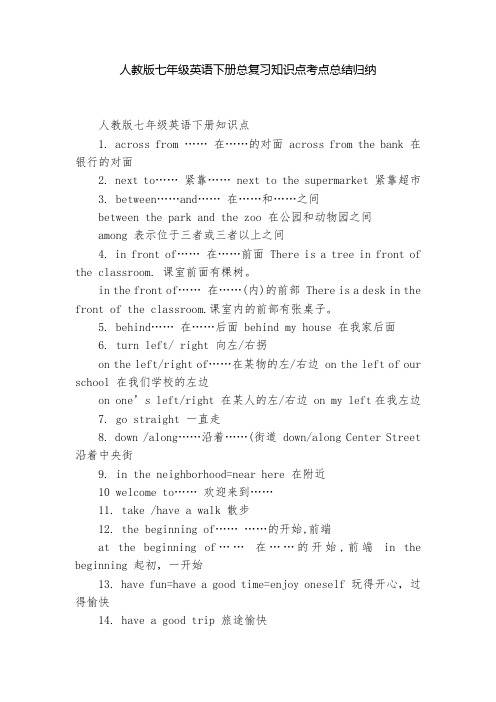
人教版七年级英语下册总复习知识点考点总结归纳人教版七年级英语下册知识点1. across from ……在……的对面 across from the bank 在银行的对面2. next to……紧靠…… next to the supermarket 紧靠超市3. between……and……在……和……之间between the park and the zoo 在公园和动物园之间among 表示位于三者或三者以上之间4. in front of……在……前面 There is a tree in front of the classroom. 课室前面有棵树。
in the front of……在……(内)的前部 There is a desk in the front of the classroom.课室内的前部有张桌子。
5. behind……在……后面 behind my house 在我家后面6. turn left/ right 向左/右拐on the left/right of……在某物的左/右边 on the left of our school 在我们学校的左边on one’s left/right 在某人的左/右边 on my left在我左边7. go straight 一直走8. down /along……沿着……(街道 down/along Center Street 沿着中央街9. in the neighborhood=near here 在附近10 welcome to……欢迎来到……11. take /have a walk 散步12. the beginning of…………的开始,前端at the beginning of……在……的开始,前端in the beginning 起初,一开始13. have fun=have a good time=enjoy oneself 玩得开心,过得愉快14. have a good trip 旅途愉快15. take a taxi 坐出租车16. 到达:get to +地方get here/ there/ home 到这/那/家 arrive in +大地方 I arrive in Beijing. arrive at +小地方I arrive at the bank. reach +地方17.go across 从物体表面横过 go across the street横过马路go through 从空间穿过 go through the forest穿过树林18.on + 街道的名称。
- 1、下载文档前请自行甄别文档内容的完整性,平台不提供额外的编辑、内容补充、找答案等附加服务。
- 2、"仅部分预览"的文档,不可在线预览部分如存在完整性等问题,可反馈申请退款(可完整预览的文档不适用该条件!)。
- 3、如文档侵犯您的权益,请联系客服反馈,我们会尽快为您处理(人工客服工作时间:9:00-18:30)。
英语七年级下册(人教版)总复习资料一、一般疑问句是以be 动、助动词、情态动词开头,用yes 或no来回答的句子。
陈述句改为一般疑问句规则如下:Ⅰ. 当句子中含有be 动词(is, am, are)时,把be 动词提到句首,主语是第一人称时要改为第二人称。
如:I am a boy. →Are you a boy?我是一个男孩。
你是一个男孩吗?you are a teacher. →Are you a teacher?你是一个老师。
你是一个老师吗?He is doing homework. →Is he doing homework?他正在做家庭作业。
他正在做家庭作业吗?Ⅱ. 当句子中含有情态动词(如can)时,把情态动词提到句首,主语是第一人称时要改为第二人称。
You can speak English. →Can you speak English?你会讲英语。
你会讲英语吗?I can dance. →Can you dance?我会跑舞。
你会跳舞吗?Ⅲ. 当句子中谓语动词是实义动词时,应在句子前加助动词do或does,如果是过去时态,则应当加did 。
疑问句中谓语动词一律用动词原形。
You speak Chinese. →Do you speak Chinese?你讲中文。
你讲中文吗?He likes English. →Does he like English?他喜欢英语。
他喜欢英语吗?He went to the movies. →Did he go to the movies? 他去看了电影。
他去看了电影吗?二、特殊疑问句(特殊疑问词+一般疑问句语序)用特殊疑问代词Who、Whose、What、Which或疑问副词When、Where、Why、How引导的疑问句。
1. What is your name? 你叫什么名字?2. Who is he? 他是谁?3. Whose pen is red? 谁的钢笔是红色的?4. Which is your pen? 哪支钢笔是你的?5. Where are you from? 你来自哪里?6. When is your birthday? 你什么时候生日?7. Why do you like koalas? 你为什么喜欢树袋熊?8. How is the weather? 天气怎么样?三、选择疑问句(一般疑问词+or+可选择部分)其回答是完整句子或其省略式。
1. Do you like apples or pears? 你喜欢苹果还是梨子?I like apples. / Apples.我喜欢苹果。
/ 苹果。
2. Is it red or green? 它是红色的还是绿色的?It is red . / Red. 它是红色的。
/ 红色。
Unit 1一、be from 来自于=come fromI am from China. = I come from China.我来自中国。
He is from China. = He comes from China.他来自中国。
My pen pal is from China. = My pen pal comes from China. 我的笔友来自中国。
1. 把上面三组句子改为否定句①含有be 动词的,直接在be 动词后加not②含有实义动词的,要借助动词do 的否定形式构成否定句,即在实义动词前加don't。
如果是第三人称单数则加doesn't,如果是过去式加didn't,动词要还原。
以上三组句子的否定句为:I am not from China. = I don't come from China.He isn't from China. = He doesn't come from China. My pen pal isn't from China. = My pen pal doesn't come from China.我的笔友不是来自中国。
2. 以上三组句子的一般疑问句及其回答为:①把be动词提到句首,是第一人称的要改为第二人称。
Are you from China? Yes, I am. / No, I am not.Is he from China? Yes, he is. / No, he isn't.Is you pen pal from China? Yes, he (she) is ./ No, he (she) is.②含实义动词的,借助动词do完成,第三人称单数用does.Do you come from China? Yes, I do. / No, I don't. Does he come from China? Yes, he does. / No, he doesn't.Does your pen pal come from China? Yes, he (she) does. / No, he (she) doesn't.3. 就以上三组陈述句画线部分(China)提问即写出三组特殊疑问句(特殊疑问词+一般疑问句语序)China 为地名,所以特殊疑问词用“Where”Where are you from? = Whre do you come from? Where is he from? = Where does he come from? Where is your pen pal from? = Where does your pen pal from? 你的笔友来自哪里?二、live 居住实义动词,表示居住在某地,其后面要加介词in.如:I live in China. 我住在中国。
He lives in China. 他住在中国。
My pen pal lives in China. 我的笔友住在中国。
1. 以上三个句子的否定句为(实义动词要借助助动词do完成否定句和疑问句):I don't live in China .He doesn't live in China .My pen pal doesn't lives in China .2. 上面三个句子的一般疑问句及其答语为:Do you live in China? Yes, I do. / No, I don't.Does he live in China? Yes, he does./No, he doesn't. Does your pen pal live in China? Yes, he (she) does. / No, he (she) doesn't.3. 就画线部分(in China)提问,及其特殊疑问句(特殊疑问词+一般疑问句语序)。
因in China为地方,所以用“Where”提问Where do you live?Where does he live?Where does you pen pal live?三、speak 讲,说实义动词,其后一般接某种语言I speak Chinese. 我讲中文。
He speaks Chinese. 他讲中文。
My pen pal speaks Chinese. 我的笔友讲中文。
1. 其否定句为:I don't speak Chinese.He doesn't speak Chinese.My pen pal doesn't speak Chinese.2. 其一般疑问句及其答语为:Do you speak Chinese? Yes, I do. / No, I don't.Does he speak Chinese? Yes, he does. / No, he doesn't. Does your pen pal speak Chinese? Yes, he (she) does. / No, he (she) doesn't.3. 就画结部分(Chinese)提问因Chinese为语言,所以用“What language(什么语言)”来提问What language do you speak?What language does he speak?What language does your pen pal speak?Unit 2一、“There be”句型“There is / are+某物/某人+某地/某时”表示“某地/某时有某物/某人。
”(某物/某人,单数用is,复数用are)。
如:There is a hotel on the street. 在街上有一个旅馆。
其否定句为:There isn't a hotel on the street.其一般疑问句为:Is there a hotel on the street?其答语为:Yes , there is. / No, there isn't.其一般疑问句可用于问路二、表示方位的句子1. The hotel is on Center Street. (on,在……上面)旅馆在中心大街上。
2. The hotel is next to the post office. (next to,在……旁边)旅馆在邮局的旁边。
3. The hotel is in front of the post office.(in front of,在……前面)旅馆在邮局的前面。
4. The hotel is behind the post office.(behind,在……后面)旅馆在邮局的后面。
5. The hotel is across from the post office.(across from,在……对面)旅馆在邮局的对面。
6. The hotel is between the post office and the library. (between ... and ... 在……与……之间)旅馆在邮局和图书馆之间。
就以上句子的画线部分提问:Where is the hotel? 旅馆在哪里?(问路的另一句型)三、指路用语go straight 直走go down / along 沿着……走turn left / right 向左/右转go through 穿过the way to ... 去……的路pass 经过take a taxi 乘出租车arrive at / in 到达……Unit 3一、提出建议的句型之一Let's do sth. (Let's = Let us,do表示动词原形)让我们做某事。
